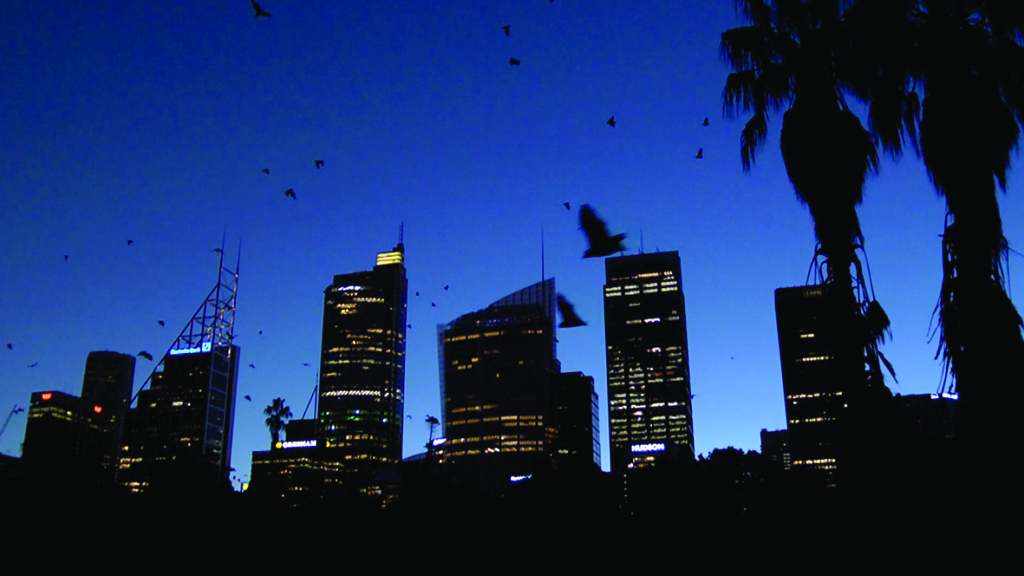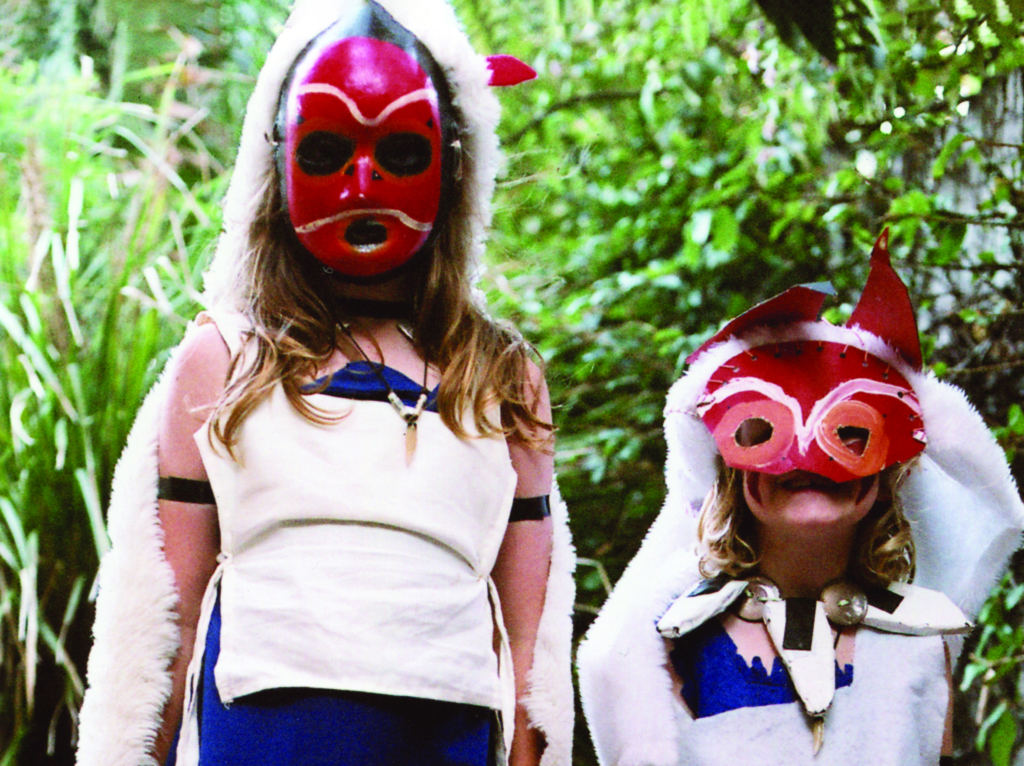Broadly speaking, documentaries about the climate crisis take a macro view – global, wide-spanning, invoking horrifying imagery that wouldn’t be out of place in a Roland Emmerich film. Even the more benign and hopeful examples of the subgenre truck in spectacle: consider the stunning vistas and daringly captured wildlife photography that are emblematic of David Attenborough’s body of work, including his recent ecological call-to-arms David Attenborough: A Life on Our Planet (Alastair Fothergill, Jonnie Hughes & Keith Scholey, 2020). Whether provoking anxiety and horror at environmental devastation or wonder at the exotic creatures and pristine wilderness under threat, the scope, in the general sense, is wide; it takes a big canvas to paint a planet.
The Weather Diaries (2020), as evinced by its very title, tacks in the opposite direction. Director Kathy Drayton’s film is intimate, personal, handmade. Rather than try to encompass the whole vast onslaught of anthropogenic climate change, the low-key and relatable The Weather Diaries focuses on a single local crisis – the decline of the fruit bat population[1]See Monisha Rudhran, ‘Imogen Jones Is Tired of People Asking Gen Z to Save the World’, Syrup, 23 September 2020, <https://www.syrupaus.com/future-focus/lupa-j-weather-diaries-interview/>, accessed 22 February 2021 in Sydney – and counterpoints it with the ascendancy of Drayton’s child, Imogen Jones, better known to the wider world as electronic musician and singer/songwriter Lupa J.
The Weather Diaries opens with shots of the Sydney CBD skyline at dusk. Dark, leathery shapes flit and flap through the darkening sky. We hear their cries. The flying foxes are leaving their roosts. From there, we cut to Sydney’s Conservatorium High School, an institution specialising in musical education, and where a teenage Jones studied at the time of filming. It’s also situated in the grounds of Sydney’s Royal Botanic Garden, which is home to a threatened bat colony. And so, with images of swooping bats set against the strains of classical music from the school, the two parallel, contrasting, yet inextricably entwined thematic and narrative threads are quickly and resonantly established. As for the Conservatorium itself, as Drayton says in the film, ‘I’m losing faith in its capacity to prepare [Imogen] for a future that becomes more uncertain and more frightening with every passing day.’

Although Drayton initially intended to make a film solely about the plight of the bat population, it is Jones’ emergence from adolescence into young adulthood and concurrent musical success that forms the spine of the film. Fifteen years old at the time the six-year production commenced, they[2]While Jones is referred to in the film by she/her pronouns, they have since come out as non-binary. See Bernard Zuel, ‘Lupa J on Unleashing the Beast Within’, Bernard Zuel author website, 12 November 2020, <https://www.bernardzuel.net/post/lupa-j-on-unleashing-the-beast-within>, accessed 22 February 2021. have, we are told, begun to eschew the classical music of their formal studies and started experimenting with electronica and pop music, recording themselves in their bedroom. Uploading songs to Triple J Unearthed soon gains them recognition, critical acclaim and a following. We see them performing at backyard party gigs; by the end of the film, they’re the opening act for luminaries such as Sarah Blasko and Grimes. It’s an incredible, laudable ascendancy; normal milestones, like graduating secondary school, pass by almost unremarked upon. ‘Maybe if I wasn’t opening for Grimes, [graduating] would be a bigger deal,’ Jones muses.
In less skilled hands, the foregrounding of Jones’ life might seem precious or self-indulgent, but Drayton has a point here and she makes it well, inviting the viewer to consider the psychological and emotional burden inherent in coming of age during what is, controversially,[3]See, for example, Peter Brannen, ‘The Anthropocene Is a Joke’, The Atlantic, 13 August 2019, <https://www.theatlantic.com/science/archive/2019/08/arrogance-anthropocene/595795/>, accessed 22 February 2021. called the Anthropocene: the period in which human activity has significantly and negatively impacted the natural world. Drayton has chosen to use her own child as her case study, employing candid home movies and ad hoc interviews to document Jones’ triumphs as their musical career takes off as well as their anxieties about the increasingly parlous state of the planet.
While it is never explicitly stated, it seems clear that The Weather Diaries’ chief thematic concern is the burden of knowledge. While it occasionally trucks in hard data and statistics, and features the occasional expert talking head, such as John Drake of Western Sydney University’s Hawkesbury Institute for the Environment, the film’s main drive is to articulate to its audience what it feels like to live now and be aware of both the horrific damage being wrought on the biosphere and the lack of action being taken to prevent it – in essence, to scent the coming crisis on the wind. At one point, Drayton ponders out loud, ‘Perhaps we’ll be the first species to record its own extinction, and that will be our most remarkable achievement.’
In terms of tone, The Weather Diaries is quite bleak. It’s not a call to action, but rather an apocalypse blog: a journal recounting if not the end of days, then at least the beginning of the end.
In terms of tone, The Weather Diaries is quite bleak. It’s not a call to action, but rather an apocalypse blog: a journal recounting if not the end of days, then at least the beginning of the end. Drayton films the efforts of wildlife-rescue volunteers to save bats that have been struck down in their thousands by record heatwaves. Mid film, she sojourns with the aforementioned Hawkesbury Institute, observing a long-running experiment wherein trees are subjected to harsher climatic conditions in order to gauge how they will fare when the now-seemingly-inevitable 3 degree Celsius increase in global average temperatures comes to pass. The prognosis is grim; the trees grow more quickly but do not live as long. The parallel to the maturing Jones is not lost on us; they, like all children, are a kind of hothouse flower, thriving under very specific, arguably artificial conditions. How will they fare when those conditions can no longer be met?
That is the question of a concerned parent, and Drayton’s identity as a mother is baked into the DNA of the film; indeed, you could argue that it’s the driving force that transformed what was intended to be a fairly contained documentary about bats into something more meaningful. Present in the film as a voiceover narrator, Drayton comes across as a Cassandra-like figure, making pronouncements of doom about the collapse of the Western Antarctic Ice Sheet and the apocalyptic bushfires of summer 2019–2020 that she herself must ignore in order to carry on. At a flying fox sanctuary, she observes a mother bat giving birth. The bat hangs upside down, pushing her baby out into the world directly against the force of gravity. ‘I am moved by her calm tolerance for pain,’ she says. She could be talking about herself.
For their part, Jones is not blind to the environmental crisis; indeed, they’ve been a passionate environmentalist since childhood. We learn that Hayao Miyazaki’s film Princess Mononoke (1997) was a core text for them. In the film, the eponymous character (Yuriko Ishida) is a feral girl raised by wolves who fights human encroachment into the wilderness alongside various animals and nature spirits. Jones identified so strongly with the character that they dressed up as her for years, including wearing the same face paint, and Drayton employs crude but charming animated inserts to illustrate Jones’ childhood obsession. Even if the costume has been abandoned, the influence remains: ‘Lupa’ is Latin for ‘she-wolf’, and Jones still affects elaborate make-up as part of their on-stage presentation. In the context of The Weather Diaries, it comes across not as mere showmanship, but as totemic war paint – an attempt to construct a more mythical, even superheroic, persona, one capable of dealing with the overwhelming challenges the world presents. While Jones may despair, Lupa J stands tall.
And make no mistake, Jones does despair. Reacting to being censured at the Conservatorium for their electronic pop music, they shave their head in rebellion and defiance – perhaps another attempt to construct a stronger persona. Reflecting on the climate crisis, they lament, ‘I’m really tired. I just feel like crying. I was much happier last year,’ before observing, ‘I think the feeling that nothing matters because the whole world is dying is really common in people my age.’ For all their success, their professional and artistic upward trajectory, the possibility of it all being futile hangs sombrely over Jones’ achievements. Contemplating their next professional moves, which include learning to DJ, they bleakly wonder if there will even be places to perform music in the future.

For her part, Drayton offers her opinion in voiceover that, in the Anthropocene, a musical path is no riskier than any other, but that is cold comfort in light of the grim picture her film paints. The Weather Diaries spends a brief moment explicating the ‘other side’ of the argument; we’re told that Drayton’s own parents’ financial fortunes are tied up in the resource industry, and that this fact commands their loyalty, giving them ‘attitudes to climate change shaped by the mining community they live and work in’. Then we spend a brief interlude with a party of costumed protesters agitating for the forced removal of a bat colony, waving signs and chanting slogans. Drayton captures a vox pop with a New Zealand man dressed as the grim reaper, asking about his motives. ‘Humans are the sharks of this land,’ he says, rather nonsensically. ‘And we will rule it.’
It’s a dismissive framing of the ‘other side’, but, then again, by the lights of The Weather Diaries, that’s as much as the ‘other side’ deserves. With her own parents as her key example, Drayton allows that there are economic, social and even generational forces that drive people to ignore or deride climate science; but that doesn’t change the facts. To deny the truth of the matter is foolish – just look at the man in the grim reaper costume.
It’s an approach that suits the film’s assumptions. For Drayton, while the future may be uncertain and terrifying, the facts are settled, and the road we’re on is clearly marked. And yet The Weather Diaries is not a polemical film. It doesn’t attack or disparage climate-change sceptics; it dismisses them, and the tone it takes in doing so is not angry or disdainful, but pitying.
Still, that does raise the question: Who is The Weather Diaries for? As stated, it’s not a polemic, and it’s certainly not a call to arms. While other recent environmental documentaries, such as Mission Blue (Robert Nixon & Fisher Stevens, 2014), often climax with a cry to rally the audience to activism, The Weather Diaries eschews such well-meaning partisanship. Drayton’s film is gloomy, dour and steeped in anxiety, charting Jones’ uptick and our planet’s downturn in tandem. Out of the countless films that have attempted to document the multifaceted existential threat that confronts us as a species, this might be the first that feels truly nihilistic, even to the point of absurdism: the planet is dying, our children will die hungry, let’s dance.
The Weather Diaries closes with a sequence of images intercutting Sydney cityscapes with footage of Jones as Lupa J performing live in concert, the vibrancy of their music contrasting against the stark, brutal urban environment that is emblematic of our impact on the natural world. The last words we hear come from a Triple J radio DJ back announcing an interview with Jones. ‘Lupa J,’ he intones. ‘She’s on her way. But to where?’ That is, indeed, the question.
Endnotes
| 1 | See Monisha Rudhran, ‘Imogen Jones Is Tired of People Asking Gen Z to Save the World’, Syrup, 23 September 2020, <https://www.syrupaus.com/future-focus/lupa-j-weather-diaries-interview/>, accessed 22 February 2021 |
|---|---|
| 2 | While Jones is referred to in the film by she/her pronouns, they have since come out as non-binary. See Bernard Zuel, ‘Lupa J on Unleashing the Beast Within’, Bernard Zuel author website, 12 November 2020, <https://www.bernardzuel.net/post/lupa-j-on-unleashing-the-beast-within>, accessed 22 February 2021. |
| 3 | See, for example, Peter Brannen, ‘The Anthropocene Is a Joke’, The Atlantic, 13 August 2019, <https://www.theatlantic.com/science/archive/2019/08/arrogance-anthropocene/595795/>, accessed 22 February 2021. |





